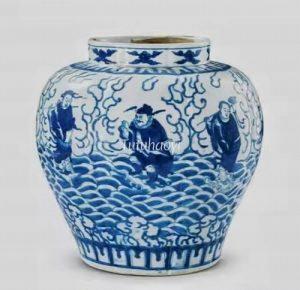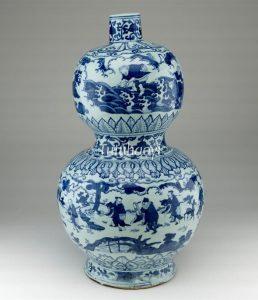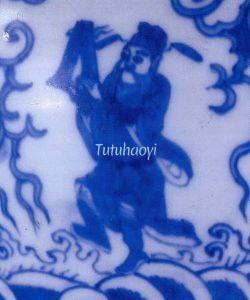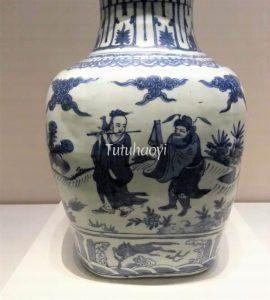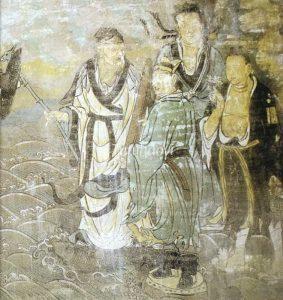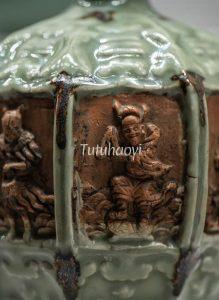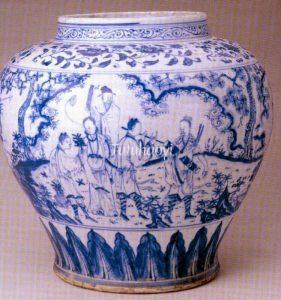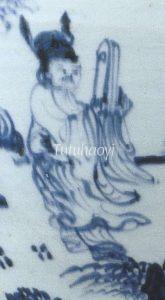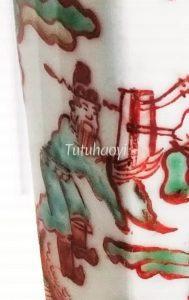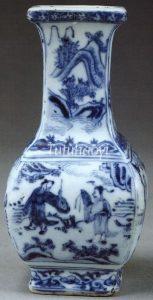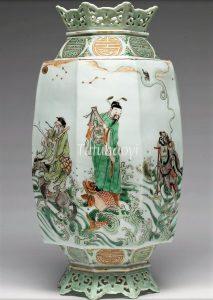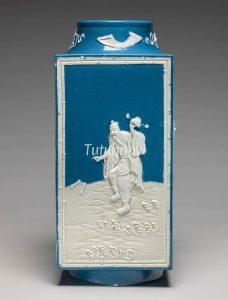Cao Guojiu
曹国舅
© Tutuhaoyi.com owns the copyright of the description content for the images attached. Quoting all or part of the description content on this page is permitted ONLY IF ‘Tutuhaoyi.com’ is clearly acknowledged anywhere your quote is produced unless stated otherwise. (本页描述内容版权归Tutuhaoyi.com所有,转发或引用需注明 “Tutuhaoyi.com”, 侵权必究, 已注开源信息的条目除外。)
Cao Guojiu (曹国舅) is one of the later comers among the legendary Eight Daoist Immortals and has the fewest colourful stories attached to him. During the Yuan dynasty (1271–1368), a Daoist priest named Miao Shanshi (苗善時 fl. 1324) compiled a collection of anecdotes about Lv Dongbin (吕洞宾, or Lü Dongbin) to promote his inner alchemical (内丹) teachings. The book is entitled the Chronicle of the Divine Transformations and Wondrous Powers of the Imperial Lord of Pure Yang (纯阳帝君神化妙通纪 Chunyang Dijun Shenhua Miaotongji). In Volume Three of the book, there is the story of ‘the religious conversion of Cao Guojiu (度曹国舅第十七化)’:
Cao was said to have been the son of a cabinet minister and an ‘Imperial Brother-in-Law (国舅)’ of Emperor Renzong (仁宗 1010–1063) of the Northern Song dynasty (960–1127). Even though he was born with a silver spoon in his mouth, he loved studying classics and enjoyed a simple life. The emperor treasured his friendship and knowledge and often had audience with him. One day, Cao decided to leave the capital and his home to travel around the world at his own free will. The emperor gave Cao a gold token to protect himself. The token bore the words: ‘Wherever the imperial brother-in-law goes, the emperor were there, too’. Cao started travelling, begging alms along the way. When he was crossing the Yellow River on a ferry, the boatman asked him to pay the fare. Cao said that he was a travelling Daoist priest and did not have any money. Then the boatman threatened to throw him out of the boat so he had to produce the gold token, the only valuable thing on him. When the passengers on the boat saw the words inscribed on the token, they all exclaimed ‘Your Majesty!’ in awe. At this moment, a Daoist priest in blue clothes on the boat said to Cao, ‘Now that you’re a Daoist priest, how could you throw your weight around to scare people?!’ Cao bowed to him humbly, saying ‘I don’t dare to, Sir’. He then threw the gold token into the river. The blue-attired Daoist asked Cao to return to the shore and, after they walked miles and settled down under a large tree, he asked Cao ‘Do you know Lv Dongbin?’ Cao replied, ‘As a mundane being, how could I know such a famous immortal?’ The blue-attired Daoist said ‘I am he. I am here to convert you.’ And the rest is history.
Ever since the Yuan dynasty (1271–1368), Cao Guojiu has been prototypically depicted as a middle-aged mandarin dressed in official robes with a winged hat and a pair of black boots. His established emblem is a set of clappers, which consists of two or more elongated bamboo or wooden pieces. This emblem is also used in the decorative motif of the Covet Eight Immortals (暗八仙 an ba xian). Since the clappers are used as accompanying instruments on stage, Cao has long been regarded as the patron deity of actors.
image identification and literature research by Dr Yibin Ni
Fig 1-2: porcelain jar with underglaze blue decoration, Jiajing period (1522–66), Ming dynasty, courtesy of Tianjin Museum, China
Fig 3: porcelain vase with underglaze blue decoration, Jiajing period (1522–66), Ming dynasty, courtesy of the Trustees of the British Museum (Franks.1672 b)
Fig 4: porcelain jar with underglaze blue decoration (detail), Jiajing period (1522–66), Ming dynasty, courtesy of The Capital Museum, Beijing
Fig 5: porcelain jar with underglaze blue decoration, Jiajing period (1522–66), Ming dynasty, courtesy of Langfang Museum, Hebei, China
Fig 6: porcelain vase with underglaze blue decoration (detail), Jiajing period (1522–66), Ming dynasty, courtesy of the National Museum of China, Beijing
Fig 7: porcelain headrest with iron brown slip painted decoration on top of a layer of white slip, Cizhou ware, late 13th century, courtesy of Preservation Institute of Cultural Relics, Fengfeng Mining District, Handan, Hebei, China
Fig 8: fresco, 1306, unearthed from Yuan-dynasty tomb No. 19, courtesy of Changzhi City Museum, Shanxi, China
Fig 9: fresco (detail), Picture of ‘The Eight Immortals Crossing the Sea’, at the Northern Gate of the Pure-Yang Hall, Eternal Joy Temple (Yonglegong), built between 1240 and 1358, Shanxi, China
Fig 10: octagonal vase with celadon glaze and unglazed medallions (detail), Longquan ware, 14th – 15th century, courtesy of The Palace Museum, Beijing
Fig 11: porcelain jar with underglaze blue decoration, Zhengtong periods (1436–50), courtesy of The Palace Museum, Beijing
Fig 12: porcelain jar with underglaze blue decoration (detail), Tianshun period (1457– 64), courtesy of The Palace Museum, Beijing
Fig 13: hanging scroll, ink and colour on silk, Four Immortals Playing with a Crane (四仙戏鹤), attributed to Liu Jun (刘俊 Active 1475–1505), courtesy of The Indianapolis Museum of Art
Fig 14: porcelain incense holder (detail) with overglaze enamelled decoration, Zhengde (1506–21) period, Ming dynasty, courtesy of the Palace Museum, Beijing, photograph by Weibo ID: Ge Gui Yu
Fig 15: limestone vase with carved relief decoration, 1500–1600, courtesy of the Rijksmuseum, Amsterdam
Fig 16: porcelain vase with underglaze blue decoration, Tianqi period (1621–27), Ming dynasty, courtesy of The Palace Museum, Beijing
Fig 17: porcelain lamp with overglaze enamelled decoration, Kangxi period (1662–1722), Qing dynasty courtesy of the Walters Museum, Baltimore, the USA
Fig 18: porcelain wine vessel, Yongzheng period (1723–35), Qing dynasty, courtesy of the Metropolitan Museum of Art, New York
Fig 19: square porcelain vase with applied decoration, Qianlong period (1736–1795), Qing dynasty, courtesy of the Fitzwilliam Museum, Cambridge
Fig 20: porcelain lamp with overglaze enamelled decoration (detail), Qianlong period (1736–1795), Qing dynasty, courtesy of the Shanghai Museum, China
Fig 21: stone carving, Qing dynasty (1644–1911), from the Eastern Qing tombs (清东陵), Hebei, China

